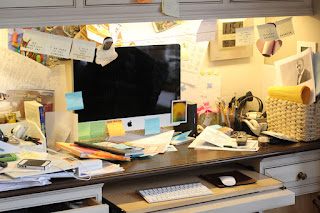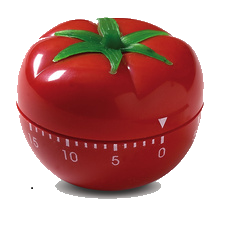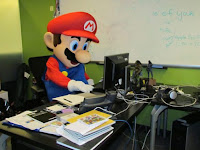The humble to-do-list
is an irreplaceable crutch in today’s hectic society. We use it as a reference
point throughout our daily lives and it helps us to feel that we have things
under control. Sometimes though, as our lives become busier our to-to-lists
become correspondingly cluttered. This can damage productivity as well as
morale and render the usually invaluable to-do-list counter-productive. Here are
ten practical, fun and easy-to-implement ways you can get the most out of your
to-do-list and maximise your productivity.
1. Separate your work and personal to-do-lists.
It might sound obvious, but you shouldn't be spending your
working hours fretting about the week’s shopping and whether or not your cat
would prefer lamb-flavoured treats this week instead of salmon (for the record,
always err on the side of salmon!). But neither should you be spending your
precious wind-down time at home agonizing over looming work deadlines. We all
know we COULD be doing more, but you’ll find yourself less overwhelmed and more
productive- both at work and at home- if you separate the two and focus on them
one at a time. The first step in doing this is to keep your personal and work
to-do-lists physically separate from each other. Try, for example, keeping your
personal to-do-lists in hard copy, like in a pocket-book or diary, and keep
your work to-do-list in easily accessible digital form- speaking of which…
2. Choose a to-do-list app or tool that works
for you.
There exists, fortunately, an array of handy to-do-list
tools and apps, many of which you can sync across all your devices, so you can
instantly access your work to-do list wherever and whenever you need to. ToodleDo,
for example, is a free task management tool which is very user-friendly and
boasts several useful features. The Scheduler is one such feature. You can create
a hotlist of your highest priority items, and so if you find yourself with a
chunk of free time, ToodleDo can identify the highest priority task that fits
into the available time slot. If that’s not what you’re looking for, here is a
list of other tools and apps which might fit your needs. Whatever you end up
with, make sure it's easy to use. The quicker you can add and remove tasks, the
more time you'll actually spend doing them!
3. Batch similar tasks in the same time-frame.
We all know how disorientating it can be when you suddenly
shift from, say, summarising a report to doing online research, and even a few
minutes spent “getting into” each different task can amount over weeks or
months to an awful lot of wasted time. One study by the American Psychological
Association found that constantly switching between tasks causes temporary
mental barriers which can deplete our productivity by as much as 40%. So,
instead of completing your tasks in chronological order, consider
“batch-processing”. This means batching together similar tasks such as
scheduling posts on social media and writing up promotional material such as
blog posts. Start by paying attention to which tasks may be damaging your
overall productivity and try organizing them into groups with their own time
slots. Consider taking a short break between each batch, which will help
revitalize you and clear your head of one set of tasks before you embark on
another!
4. Physically remove distractions.

While we’re on the subject of shifting your focus between
tasks, it’s worth noting that unnecessary interruptions such as phone calls,
notifications, excess noise and disturbances in the office can be detrimental
to getting work done. Gloria Mark of the University of California, Irvine found
that a typical office worker gets only about 11 minutes of work done between
each interruption, while it takes an average of 25 minutes to return to the
original task after an interruption, which is alarming to say the least!
Interruptions are part and parcel of office life and there is only so much we
can do to
minimize distractions, but we can start by removing those that are
not necessary to work, such as mobile phones where any calls, texts or
notifications will be personal and can be dealt with later. Try setting your
phone to airplane mode when you are in work, or keep it in your bag while you
are working. Similarly, it’s worthwhile to keep your desk clear and uncluttered
and to remove any object that you find distracting. Suppose you have a habit of
straightening or flicking through papers on your desk? Keep them in a folder
instead and put them away until you need them.
5. Set blocks of time in which to complete
tasks.
Speaking of interruptions, it’s a good idea when you have an
important project that needs to be done to literally reserve a block of time on
your online calendar for that task. It means others will know not to interrupt
you during that time and you can work for long stretches without being
disturbed. Need to do some last-minute prep for a presentation at 4 p.m.? Block
1-2 hours in the morning or after lunch so no one bothers you during that time.
Need to do some research before an important call? Block the half hour before
the call starts. Do you feel you have to answer every call right when it comes
in? Set aside time blocks to deal with non-urgent calls, and let your voice
mail tell callers when they can expect to hear from you.
6. Write out your to-do-list the day before.
This is a good idea for several reasons. First and foremost,
and before you even get into the office, knowing that you have everything
organised for tomorrow will help you get a good night’s sleep tonight. Studies
have shown that when we lose just one night’s sleep, our cognitive capacity is
roughly the same as being over the alcohol limit- not ideal for productivity.
Secondly, you’ll be able to get right to work first thing in the morning,
kick-starting your day. Also, planning out your day in

advance can help you
spot obstacles ahead of time. You’ll get so much done during the day that you
can afford to spend a few minutes at the end of each work day looking over your
calendar and compiling your to-do-list for tomorrow!
7. Work in “sprints”.
There have been several studies on the benefits of working
in “sprints”- working intensely for short periods of time with breaks in
between. Tony Schwartz, an engagement consultant who's worked with the likes of
Google, Facebook, and Coca-Cola, makes an intuitive argument: that since
quality work requires focus, and you only have the energy to focus for so long,
you need to be conscious of how and when you focus in order to do your best
work. Your mental energy is a renewable resource. It doesn't refresh on its’
own. Aside from that, your time away from work allows you to prioritize, so
that when you do get to work, you know exactly what needs to be done. This step outside the box allows you to
differentiate between minutia and the real actions that will get you closer to
accomplishing your important tasks. The Pomodoro Technique is a
productivity-boosting technique developed by Francesco Cirillo in the late 80’s
that can help you concentrate for longer periods, avoid distractions, maintain
higher energy throughout the day, and lower your stress levels. The technique
uses a timer to break down work into intervals,

traditionally 25 minutes in
length, separated by short breaks. These intervals are called pomodoros, which
is Italian for tomato (named after the tomato-shaped kitchen timer that Cirillo
used as a university student!). The method is based on the idea that frequent
breaks can improve mental agility.
8. Reward yourself!
For a variety of reasons, sometimes breaks alone are just
not enough to motivate you to keep focused. In any case, a rigid system can get
boring, so shake things up by allowing yourself rewards! Try, for example,
allowing yourself a coffee break with a co-worker or a snack after you've
knocked a set amount of items off your to-do-list. Shake things up a little and
try to vary your rewards week by week, as well as setting rewards that are
proportionate to the intensity of the work you have done. Not only will this
obviously help motivate you to complete tasks, but it will also reward your
overall mental health by not allowing your work days to become too gruelling
and monotonous. You can implement the work/reward system on both a small level
and a larger one- small rewards on a day-to-day basis as well as planning
larger rewards for the weekend when you know you have a tough week coming up.
If you can get a co-worker on board, wherein both of you plan an activity
together which you can partake in once you both have a set amount of work done,
you can mutually keep each other accountable in a way that is fun and rewarding
for both of you. A more enjoyable workplace makes individuals perform better,
in almost every aspect of their lives.

9. Share your to-do-list.
Even without the work/reward system, it’s a good idea for
co-workers to keep each other accountable for work done by sharing their
to-do-lists. First of all, the mere fact of having to share your to-do-list
will force you to prioritize and will create a healthy amount of pressure to
complete your work in a timely fashion. Living in the age of technology means
that it is very easy to do this, as you probably already use collaborative
project apps such as Trello or others mentioned in
this article.
10. “Gamify” your to-do-list!

Finally, a wonderful way of simultaneously putting pressure
on yourself while also making your work more enjoyable- two concepts which are
so often at odds with each other- is to “gamify” your work. Gamification is the
application of game playing elements to non-game environments- more
specifically, introducing game-playing elements into the workplace. There have
been a number of studies examining the effects of gamification on employee
wellbeing and productivity, with mixed results insofar as the benefits and
drawbacks are concerned when applied to groups of workers. However, you can
introduce elements of gamification into your individual work where practical.
Try, for example, the “Dead Battery Countdown”. This is an interesting
productivity trick I came across in
this article. Try unplugging
your laptop and resolving to complete your to-do-list, or at least a number of
items from it, before the battery runs out. This is a useful trick as it
creates a sense of urgency which is hard to replicate within the environment of
your usual daily activities. It is also a way of gamifying your productivity,
which can be invaluable in keeping you focused and working smarter.








